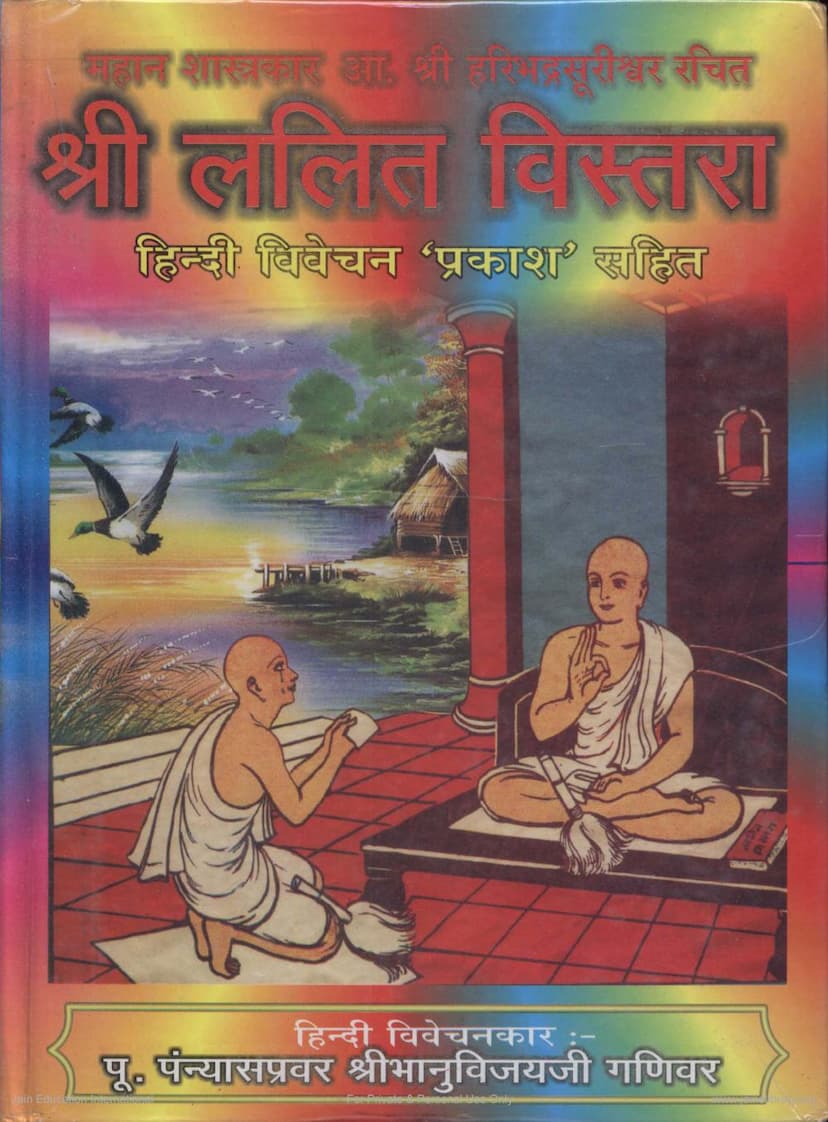Lalit Vistara
Added to library: September 2, 2025

Summary
The text you provided is a detailed exposition of the "Lalitavistara," a commentary on the Jain Chaityavandan Sutra, attributed to Acharya Haribhadrasuri. The provided pages cover the introductory and analytical sections of the work, including its publisher, author lineage, and extensive reviews and introductions. Here's a comprehensive summary in English:
Book Title: Lalitavistara Author(s): Haribhadrasuri, Bhuvanbhanusuri (as commentator/editor) Publisher: Divya Darshan Trust
Overview:
The "Lalitavistara" is a commentary by the renowned Jain scholar Acharya Haribhadrasuri on the Chaityavandan Sutra, specifically the "Namosthu" (नमोत्थुणं) verse addressed to the Arhats. This particular edition features a detailed Hindi commentary called "Prakash" by Pt. Bhanu Vijayji Ganivar, a disciple of Acharya Vijay Prem Surishwarji. The text is presented as a collection of the original Prakrit (or Ardha-Magadhi) Chaityavandan Sutra, Haribhadrasuri's Sanskrit commentary "Lalitavistara," Muni Chandrasuri's Sanskrit commentary "Panjika," and Bhanu Vijayji's Hindi commentary.
Key Aspects and Content:
-
Authorship and Lineage:
- The original author of the Lalitavistara is Acharya Haribhadrasuri, a prominent figure in Jain literature, known for his profound scholarship and vast output (1444 treatises).
- On the Lalitavistara, Muni Chandrasuri wrote a commentary called "Panjika."
- The Hindi commentary "Prakash" is by Pt. Bhanu Vijayji Ganivar, a learned and ascetic disciple of the highly revered Acharya Vijay Prem Surishwarji Maharaj.
- The publication is dedicated to Acharya Devesh Shri Vijaypremsurishwarji Maharaj.
-
The Lalitavistara's Significance:
- The Lalitavistara is described as an "alaukik koti" (supernatural level) commentary that elaborates on the Chaityavandan Sutra's verses.
- It's noted for its rigorous logic and philosophical depth, presenting the unique superiority of Jain philosophy and the Arihant परमात्मा.
- A significant anecdote mentions that Acharya Siddharsi Gani, who was initially swayed by Buddhist philosophy, found his wavering mind converted to unwavering faith in Jainism after studying the Lalitavistara. His profound scholarly work, "Upamit Bhavaprapanch Katha," is cited as a product of the deep spiritual insights gained from this text.
-
The Chaityavandan Sutra and its "Namosthu" Verse:
- The "Namosthu" verse (नमोत्थुणं अरहंताणं...) is a Mangalacharana (auspicious invocation) and a veneration of the Tirthankaras.
- Haribhadrasuri's commentary goes beyond mere translation, providing detailed explanations of each word, revealing the entirety of Jain philosophy.
- The verse is rich in epithets for the Arihants, describing their divine qualities, powers, and roles as guides, saviors, and exemplars. These epithets cover aspects like their unique virtues, omnipotence, compassion, role as spiritual guides, and their ultimate attainment of liberation.
-
Commentaries and Translation:
- The text highlights the importance of the Panjika commentary by Muni Chandrasuri for clarifying the difficult aspects of Haribhadrasuri's work.
- The Hindi commentary "Prakash" by Pt. Bhanu Vijayji is praised for its simplicity and clarity, making the profound teachings of the Lalitavistara and Panjika accessible to even young minds and the general public.
-
Content of the Commentary (as detailed in the index/table of contents):
- The book delves into the essence of Dharma, the characteristics of a Dharma Adhikari (one fit for religious discourse), the means of acquiring knowledge, and the nuances of Jain Darshan (philosophy) in relation to other darshanas.
- It elaborates on the Arhat's unique characteristics, divine powers, and their role as benefactors (giving fearlessness, sight, path, refuge, knowledge, dharma).
- Detailed discussions on core Jain principles like Anekantavada (non-one-sidedness), the nature of soul and non-soul substances, karma theory, the path of spiritual ascent (Gunasthanas), and various philosophical concepts are covered.
- The text includes critiques of other philosophical schools (Samkhya, Nyaya, Vedanta, Buddhism, etc.), highlighting Jainism's distinctiveness.
- The commentary meticulously analyzes each verse of the "Namosthu" mantra, explaining its philosophical implications, linguistic nuances, and its relevance to spiritual practice.
- It also discusses the importance of devotional practices like Chaityavandan, Pujas (Dravya Stava, Bhava Stava), and the philosophical underpinnings of these rituals.
- The introduction by the Governor of Rajasthan, Shri Sampurnanandji, emphasizes the value of Jain philosophy for all students of Indian philosophy, noting its unique position as an Avedic system that preserves ancient traditions.
- Professor Dr. P. L. Vaidya's introduction underscores Haribhadrasuri's comprehensive knowledge of Hindu philosophical systems alongside Jainism and the significant contribution of the Hindi translation for the lay community.
-
The Purpose of the Publication:
- The publishers express immense joy in publishing these three gems: the Lalitavistara, the Panjika, and the Hindi commentary.
- They hope that the study of this great scripture will provide guidance and profound spiritual knowledge.
- The publication is intended to foster devotion towards Arihants, spread the virtues of Jain philosophy, and attract people to the path of liberation.
-
Structure and Presentation:
- The publication includes both the Sanskrit original texts (Lalitavistara and Panjika) and the Hindi commentary.
- Special attention has been given to the Sanskrit texts for scholars, with paragraphing and clear marking of original verses within the commentary.
- A detailed table of contents is provided for easy navigation.
In essence, this work is a comprehensive spiritual and philosophical treatise that expounds the foundational Jain mantra, highlighting the profound teachings of Jainism through the lens of its rigorous logic, philosophical insights, and devotional practices, made accessible through an extensive Hindi commentary.